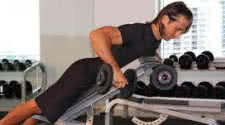Perfect Exercise Execution - Incline Dumbbell Rows for Back Muscles

Get the Optimal Results with your Training with Proper Advice
By virtue of the strictness and full range of movement inherent in its execution, this exercise is a prime mass builder for the lats and
upper back. As heavy dumbbells are the order of the day, you may find (because you are in a fixed and supported position) that this
exercise is uncomfortable for your chest. If you do, substitute lighter weights and shorter rest intervals for a session in lieu of the
full workload. With a little practice, you will get used to the position and will be able to handle maximum weights for maximum gains.
STARTING POSITION
Place your chest against the pad of an incline bench set at about 40 degrees - the ideal angle for hitting the rhomboids and lats. Grasp a dumbbell in each hand. Let the weights hang straight down at arms' length. Make sure you are in a stable, fixed and safe position. Adjust hips, thighs and feet to ensure that you are comfortable, supported on the bench and focused completely on lifting the weights and targeting the muscles.EXECUTION
» With the dumbbells hanging straight down, flex your lats and drive your elbows back.» Keep your shoulders down as you raise the dumbbells as high as possible.
» Control the weight throughout the lift, pulling smoothly. At the top position, squeeze your shoulder blades together.
» Lower the dumbbells while continuing to keep tension art your lats at all times.
» If the exercise hurts your chest, use lighter dumbbells and focus on the feel of driving your elbows back and pinching your shoulder blades together as you squeeze for a peak contraction.
One of the keys to learning how to train the back to its muscular potential is the mind-muscle link. Perhaps you've read about the mind-muscle link before. It may sound too esoteric for your routine, but back training requires a higher level of concentration since you can't see the muscles working; you can only feel them. Here are a few things to keep in mind to help you get there.
Try flexing your back muscles without weight or resistance. Go through the physical motions of the movements, tensing the areas particular exercises work. For instance, to practice the mind-muscle link with pulldowns, work on pulling with your lats, not your arms. Put your mind into your lats, and imagine they're attached to the cable handle, not your hands. Use ultra low resistance to practice before you do a proper set.
Think of your arms as levers during back exercises. It helps to think of pushing the elbows back or pushing the elbows down instead of pulling, because when you think pull, you tend to grip tightly and involve the biceps too much. Push back and squeeze your shoulder blades together and keep your shoulders down.
Visualize a tremendously developed back such as Dorian Yates and imagine what his specific back muscles would look like doing the movement you're doing. That will help you keep your focus in the right area.